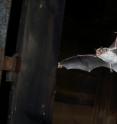Bats are surprisingly fast decision makers
Bats are not as stereotyped when they hunt as previously believed. New research shows that these flying mammals are capable of making ultra-fast decisions about how to attack their prey -- or maybe even call off the attack. It takes only milliseconds. Bats use echolocation for orientation. They emit ultrasonic sounds, which hit potential prey nearby, sending an echo back to the bat. From this echo the bat can define where the prey is and attack it. A new study has examined how hunting bats react when approaching their prey. The study concludes that bats are capable of gathering information from the environment and process it surprisingly fast in order to determine how to carry out the attack or maybe call it off.
"A bat is capable of adjusting its attack until it is approximately 100 milliseconds away from its prey," explains Signe Brinkløv, postdoc at the Department of Biology, University of Southern Denmark.
"It is surprising that they are so fast. Until now we thought that bats are deploying a kind of autopilot in the last phase of an attack limiting them to an unchangeable behavioral pattern."
Part of the research team are also Professor Annemarie Surlykke from University of Southern Denmark and colleagues from the Ludwig-Maximilian University in Munich. The team studied hunting bats both in the laboratory and in nature. The study is published in the journal PNAS.
Researchers removed the prey
In both the bat laboratory at the University of Southern Denmark and in nature, the researchers offered prey to the bats. When the bats started their hunt for the prey, the researchers removed it and observed how the bats reacted.
The researchers recorded the sound emitted from the bats and filmed how and when the bats responded to the disappearance of the prey.
"As the bats approached their prey, they were continually able to adjust their attack and maybe call off the hunt entirely if we took away the prey. They had this capability until less than 100 milliseconds before reaching their prey. This tells us that bats can process complex information and make decisions in an extremely short time," says Signe Brinkløv.
She points out that qualified decision-making is not to be confused with reflex reactions.
"Sometimes we also see reaction times of only 20 milliseconds in bats, for instance in response to loud sounds, but that is a simple reflex reaction that does not require brain work."
Signe Brinkløv thinks that bats' ability to make quick decisions is a result of evolution.
"They rely on being able to react extremely quickly when they hunt, so I would think that they've been under strong evolutionary pressure to develop such expedited reactions in order to survive as a species," she says.
How bats hunt
Bats use echolocation for orientation. They emit ultrasonic sounds, which hit potential prey nearby and send an echo back to the bat. From this echo the bat can define where the prey is and attack it.
Source: University of Southern Denmark
Other sources
- Bats are surprisingly fast decision makersfrom Science DailyWed, 18 Mar 2015, 18:00:06 UTC
- Bats are surprisingly fast decision makersfrom PhysorgWed, 18 Mar 2015, 16:30:25 UTC
- Bats are surprisingly fast decision makersfrom Science BlogWed, 18 Mar 2015, 16:30:10 UTC
